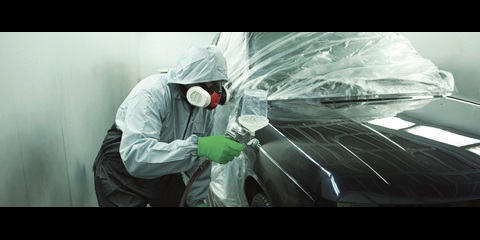
From regulation-driven innovation to futureproof solutions
Coatings and adhesives are typically produced using chemicals such as binders, crosslinkers, solvents, and additives. Handling these chemicals properly throughout the value chain is essential to keeping consumers, manufacturers, and end-users safe, and to minimizing the industry’s environmental impact.
As such, assessing these chemicals is a high priority for both the coatings industry and governments. Both nationally and internationally, there are a range of regulations requiring chemicals’ environmental and health impact to be evaluated and classified. These classifications are often based on the Globally Harmonized System of Classification and Labelling, and influenced by organizations such as the World Coatings Council.
Complying with these regulations is a pre-condition for the success of individual coatings companies, as well as for the industry as a whole. As well as following industrial hygiene requirements, many companies aim to exceed them, or even to implement their own standards if local regulation is insufficient.
At Covestro, we strive to offer our customers raw materials that are safe for their intended use, and that meet or exceed regulatory requirements for industrial hygiene. In fact, by offering differentiating solutions, we aim to help our customers turn the perceived risk of upcoming regulation into an opportunity to increase value. In this way, manufacturers and end-users in industries from mobility to printing and packaging can contribute to a safer, more sustainable coatings industry.
Challenge: Keeping up without compromising performance
Industrial hygiene regulations can change fast. To stay compliant, coatings producers must keep up to date and adapt their products – and/or their labeling – quickly where necessary.
Not only that, but regulations can also vary – or even contradict each other – between regions. For coatings producers with a global presence, this can make keeping up with requirements particularly demanding – especially when considering local supply and availability.
Restrictions imposed by industrial hygiene regulations can also be very specific, and aren’t always application-driven. This can make it difficult to balance compliance with continuing to meet the needs of end-users, minimize costs, and maintain high performance.
Within Europe, the European Green Deal will bring particularly significant regulatory changes in the coming years. The Green Deal’s policies on climate neutrality and the circular economy, and its Chemicals Strategy for Sustainability (CSS), will directly affect the coatings and adhesives industry. Under the CSS, the substances of very high concern (SVHC) list will be extended, and more sustainable innovation will be promoted.
Alongside the CSS, the EU’s Fit 4 Future directive will also introduce substance and product reclassification and restrictions. Aimed at reducing humans’ and the environment’s exposure to chemicals, Fit 4 Future could affect 50-70% of products in the chemical industry.
At Covestro, our challenge is to deliver solutions that help our customers keep ahead of these regulatory requirements for industrial hygiene, while continuing to differentiate themselves in their national, regional, and local markets.
Status: Continuous optimization
We don’t just follow current product regulations – we go further by keeping track of the direction policies are taking to anticipate the development of upcoming requirements. In fact, as experts on our raw materials, we often participate in discussions leading to potential upcoming legislation.
To be a reliable partner for our customers, we carry out risk assessments on all our raw materials to ensure that they are safe for use and can be offered to the market. Where there are signals of upcoming changes in legislation, we act early and decisively to bring you optimized solutions, adapting our portfolio when necessary. This can mean reducing or replacing substances of concern in our existing formulations, or developing new alternatives altogether.
To make this innovation possible, we stay up to date on more sustainable raw materials and intermediates and work to address further industrial hygiene opportunities. In this way, we strive to offer solutions that meet or exceed upcoming regulations before these regulations are introduced.
To make transitioning to these solutions easier, we focus on more than regulatory compliance itself. We also aim for these solutions to enable benefits such as strong functional performance, cost-effectiveness, and improved productivity. And we provide technical support on these products, to help you handle them safely and get the most from them.
Ultra line crosslinkers
Our Ultra line of crosslinkers is a great example of how we continuously improve our products to set new standards in industrial hygiene. Aware of likely upcoming restrictions on diisocyanates, we developed the Desmodur® Ultra range.
With under 0.1% residual monomeric free diisocyanate content, these innovative, high-performance crosslinkers set a new standard for industrial hygiene, keeping quality up and helping your business become future-ready.
Since then, we’ve expanded the line and adapted it further to offer improved long-term stability and, with the partly bio-based CQ Ultra line, greater circularity.
Food contact compliance
We support our packaging customers with food contact compliance statements. These are based on measurements of the substances in our materials, toxicology assessments, and detailed discussions to assess the potential impact of upcoming legislation. Alongside this, we will replace chemicals that are no longer allowed and reduce chemicals of concern in our products.
Replacing NMP and APEOs
Fifteen years ago, we were already starting to replace products containing N-Methyl-2-pyrrolidone (NMP) and alkylphenol ethoxylates (APEOs) worldwide.
So, when these substances were banned from the European market in 2020 and 2021 under REACH legislation, our customers already had established replacements available. This made it easier for them to differentiate their portfolios and capture additional market share.
If similar regulations in other markets follow, these customers will also be prepared – an example of how our global approach helps to futureproof your portfolio.
Next: Toward futureproof product design
Our next solutions include continued portfolio adaptations to help you meet the regulatory challenges that lie ahead. To make these adaptations proactively, our dedicated ‘Fit 4 Future’ team works continuously to futureproof our portfolio by reducing or substituting chemicals of concern, communicating any changes to our customers. For instance, we plan to use a cumene-depleted solvent in our Uralac® and Desmodur® grades in Europe ahead of the reclassification of cumene at the end of 2023, enabling you to avoid additional labeling while maintaining high performance.
Even more, though, we’re shifting our focus to innovation. Some of our new solutions will include replacements for phased-out products. But our Fit 4 Future team also evaluates and introduces brand-new products that enable improved safety, circularity, and functionality throughout their lifecycles. In alignment with the CSS, we work to ensure that these new innovations are safe and sustainable by design (SSbD).
Most importantly, we work with our customers and partners to understand how they apply and use our products. We then invest in R&D and take an ‘innovation platform’ approach, with combined technologies and cross-disciplinary teams. In this way, we are even better equipped to meet your needs while building regulatory compliance into our products’ design.
By helping to enable these innovations – locally, nationally, and globally – we hope to do more than keep you ahead of upcoming regulations. We want to work with you toward a world where less regulation is needed, thanks to products that achieve the standards that producers and end-consumers need from the very beginning.












